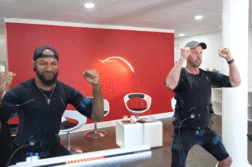LOS ANGELES, Calif. (Ivanhoe Newswire) — Hair loss can be distressing for anyone, but it’s particularly devastating for most women. 30-million American women live with hair loss, according to the American academy of dermatology. A woman from the u-k brought over a hair loss prosthetic system that’s non-invasive, easy to maintain, and described as “life-changing” by her clients.
Priyanka Guha’s long, beautiful hair looks natural. But for the past decade, that hasn’t always been the case. She started losing hair from female pattern baldness in her twenties. She tried tonics, powders, and extensions to hide it.
Guha shared, “Over time, I would wear more and more hair clip-in extensions and finally, when I started losing so much hair that I felt like I had to cover it up, especially on the top of my head.”
Then she found Lucinda Ellery and her Intralace system in Los Angeles.
“We integrate strand by strand your hair through a mesh. The mesh is thin, thin, thin. You can’t feel it. Weightless and breathable,” Ellery described the hair system.
That mesh is held in place by Guha’s hair and strands of human hair braided and glued together. Then, this hair piece is secured.
Ellery said “You can wash, brush, set, dress, swim, shower, swing from chandeliers and nobody should be any the wiser that you’re all faked up.”
The results are dramatic, as you can see with some before and after photos of clients. The process can take a full day and costs one to 3,000 dollars. Guha says it’s worth every penny.
“I appreciate it so much. This is … it makes me feel normal, and I didn’t feel normal before.” Guha shared.
Clients need to have their hair systems maintained every six to eight weeks, which Ellery says is comparable to having regular hair appointments. The average cost is 225 dollars for each maintenance service. Insurance has covered some procedures. There are a couple of reviews complaining about cost, itching, and hair breakage, but for the most part, clients are extremely pleased with their results. There are Lucinda Ellery salons in LA and New York, and another one coming to San Francisco.
Contributors to this news report include: Wendi Chioji, Producer; Rusty Reed, Videographer; Jamison Koczan, Editor.
To receive a free weekly e-mail on Medical Breakthroughs from Ivanhoe, sign up at: http://www.ivanhoe.com/ftk



